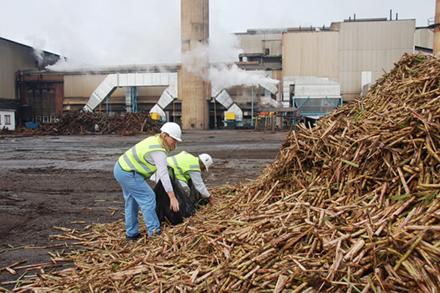Sweetening the Deal

Researchers collect samples of sugarcane prior to processing to see if it is infected with bacteria. (Photo courtesy of Isabel Lima)
Researchers and the Sugar Industry Join Forces to Refresh the Environment
The average American consumes 17 teaspoons of sugar per day, about half from sugarcane. It takes a lot of raw material to create all that sweetness, but there is a downside – what do you do with all the leftover sugarcane processing waste?
Scientists with the Agricultural Research Service’s (ARS) Southern Regional Research Center (SRRC), in New Orleans, LA, are working with the sugar industry to improve processing methods and develop new products that will benefit the environment and increase profits.
According to Thomas Klasson, chemical engineer and research leader of SRRC’s Commodity Utilization Research unit, the project aims to develop biobased products to replace petroleum-based products, and to refresh the soil with amendments made from sugarcane processing waste.
“Our work with waste utilization will replace products that are now made from dwindling or non-renewable resources,” he said. “Our approach is greener and more environmentally friendly.”
Mill mud, a gooey mess that is a byproduct of the sugar purification process, is one of the focal points of the research. Also known as “filter cake” or “press mud,” it is an enriched sludge that is full of organic carbon, nitrogen, and nutrient minerals. Sugar mills may be able to generate additional income by returning this waste to the production cycle.
“Mill mud has nitrogen, phosphorous, potassium, and many other compounds that provide excellent fertilizer value,” Klasson said. “Right now, we are considering it for field applications because of the amount the sugar mills produce; however, adding it to potting soil may also be an option.”
Sugar mills produce about 5 pounds of mud per 100 pounds of processed sugarcane.
“If all the mud from Louisiana sugarcane factories – which process about 1,900,000 tons of sugar cane a year – could be recycled as fertilizer, we would save 2,100 tons of nitrogen fertilizer and 950 tons of phosphorous fertilizer,” Klasson said.
Mill mud is frequently used to improve sugarcane fields, where it can help restore fertility to sandy soil and land affected by erosion or biomass burning.
“With some waste, we are making plastics or converting it into chemicals that can replace chemicals that are now made from petroleum oil,” Klasson said. “One of the wastes that we work with is bagasse, which is the rest of the sugarcane plant once the sugar is removed.”
Often, bagasse never leaves the sugar mill because the industry uses it as an inexpensive fuel source. There are, however, many other uses, including paper, particle board, mulch, animal bedding, and transportation fuel.
Bagasse has also found a home on cattle ranches and dairy farms as inexpensive roughage for herds, and as a natural filter to remove organic and metal contaminants from water.
“As resources become more scarce and fossil-based fuels and chemicals get more expensive, the use of agricultural byproducts will increase,” Klasson said. “As the population grows, we will consume more sugar, and there will be an increased need to find uses for these wastes.” – by Scott Elliott, ARS Office of Communications.
Also in our Mardi Gras series:

